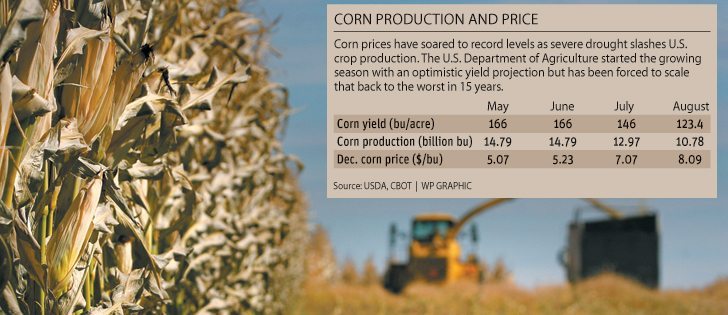Grain markets might soon feel the effects of two transportation issues in the United States, one related to drought, the other to a possible railway labour disruption.
U.S. crop exports, particularly corn, are already lagging expectations and are limiting hopes for a price rally, and that negativity could spread into wheat and other crop markets. The situation could worsen if it becomes even harder to get American grain to export position.
River shipments of grain and other commodities are restricted because of low water levels on the Mississippi River, the pipeline for 60 percent of America’s crop exports, particularly corn and soybeans.
Read Also

Flax sector sees omega-3 opportunity
SASKATOON — A global shortage of omega-3 oils could be an opportunity for the flax sector, says an industry official….
The low water levels are a symptom of lack of rain throughout much of the U.S.
Meanwhile, those who use the country’s railways are on alert as 12 labour unions representing workers vote on the latest offer from Class One railway companies.
The offer was developed with the help of an emergency board created by U.S. President Joe Biden in September.
So far two unions representing about 25 percent of workers have rejected the offer. Sick leave policies are the key point of disagreement.
Six smaller unions representing about 19 percent of workers have accepted the offer.
The two biggest unions, representing about half of all workers, are expected to release voting results on Nov. 17.
If even one union voted to strike, it would have a strong potential to shut down the whole system because other unions would respect the picket line.
The last time a labour-management dispute shut down U.S. railways was in 1992.
The unions and companies have an agreement to maintain the status quo until early December, meaning no lockout or strike until then.
Negotiations will continue, but if things go badly it would likely force the U.S. Congress to consider pre-emptive legislation to force a resolution or to put the parties into binding arbitration. A railway shutdown would cost the U.S. economy an estimated US$2 billion a day.
Any way you look at it, the coming weeks will be a time of high anxiety for shippers.
In the event of a strike, normally the Mississippi River barge system would become even more critical to America’s economy, but current water levels are near record low.
About 80 percent of the contiguous U.S. has below normal rainfall in recent months. Sixty-three percent of the lower 48 states is in some level of official drought from moderate to exceptional. The geographic extent of the drought has not been seen since the fall of 2012, according to the U.S. Drought Monitor.
The coming winter is expected to intensify and spread the drought in the Plains and the western part of the country, meaning low water levels extend to the Missouri and Arkansas rivers that feed into the Mississippi. Some relief might come from the forecast for improved moisture in the eastern part of the Midwest, which is an area drained by the Ohio and Illinois rivers. They are also tributaries of the Mississippi.
Because of the low water levels, barges on the lower Mississippi can’t carry a full load, meaning each barge moves 10,000 to 15,000 fewer bushels than normal.
Also, barges are usually tied together with 30 or more pushed along by one powered vessel. Now a maximum of only 25 can be connected on the lower Mississippi.
In many cases, barge spot rate costs are double or triple what they were last year at this time.
The problems have caused some crop export business to move to the Pacific Northwest or to South America, according to Bunge Ltd. Grain executives have also said it could push back some exports until later in the marketing year.
American crop exports so far this marketing year are generally down, particularly for corn.
The combination of crop exported and sales on the books stands at 14.09 million tonnes for corn, down 53 percent compared to the same time last year.
Wheat exports and sales are at 11.82 million tonnes, down six percent.
Soybean meal and soy oil are also behind last year’s pace, but soybeans, at 31.55 million tonnes, are up five percent.
The expense of barge shipping and the very strong American dollar relative to other world currencies are making U.S. corn and wheat uncompetitive on the world stage.
The U.S. Department of Agriculture is already scaling back its forecast for full year corn exports to 54.6 million tonnes in the October supply and demand report from 60.33 million in the August report.
China’s imports of American corn are lower than expected. China might soon start importing corn from Brazil because it has approved many suppliers in that country after the governments of Brazil and China solved disagreements about phytosanitary issues affecting corn, paving the way for expanded trade.















